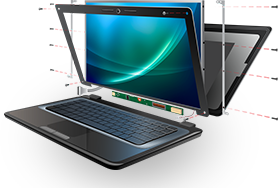Dead pixels are defects of LCD production. These can be caused by misalignment, improper cuts or dust particles landing on the LCD matrix during production. Generally LCD panels that leave the factory for installation in laptops or for parts resale have been inspected for dead pixels. Over the years the quality control standards for LCDs have improved a lot, and as technology became more affordable, factories began to dispose of the more obvious defects that would have been shipped to customers just a few years earlier. Still, most LCD manufacturers and laptop vendors allow some amount of pixel defects to exist without it giving a rise to a warranty claim.
Pixel defects can be divided into three sub-categories: Dark pixel, Bright Pixel, or a Dark/Bright Sub Pixel. Each pixel on a typical LCD panel is made up of three sub-pixels: Red, Green and Blue. Pixel defects can happen to an entire pixel (all three sub-pixels affected), or can only affect one or two colors in the sub-pixel.
So what can be wrong with a pixel?
Due a defect a pixel may not “turn on” – meaning it does not pass the light from the backlight, and will remain dark, these are called Dark Pixels. A pixel also may not turn off – meaning the pixel will stay transparent and the light from the backlight will shine through continuously, these are called Bright Dots.
The same can happen to an individual sub-pixel by itself to make for a partial pixel defect. These are not as noticeable because sub-pixels are three times smaller, but if they remain bright, they can still be quite visible and annoying.
What can be done about dead pixels?
Typically dead pixels cannot be fixed, however any “dead” pixel can be a “stuck pixel” that is experiencing problems intermittently. Stuck pixels can appear due to shock, pressure or long periods of electrical inactivity, but unlike dead pixels, stuck pixels are not permanently dead, and can be revived by:
– Running imaging software that circulates color patterns on your screen for a duration of time, which may help nudge the stuck pixels into normal operation.
– Sometimes stuck pixels can be gently massaged into operation, this typically affects Dark dots best – since they are off due to a lack of electrical contact.
– Some methods include applying heat to the LCD surface, we have never seen this method work for us, and we don’t recommend it since it can cause further damage to working pixels near-by.
What does LaptopScreen.com do about dead pixels?
LCD Manufacturers and laptop Vendors maintain pixel policy that allows for a certain number of defects for them to “close their eyes” on the problem and claim it to be fully functional. A typical dead pixel policy allows them up to four Dark Dots in conjunction with no more than two Bright Dots for the LCD panel to be considered defect-free.
Unlike laptop vendors, LaptopScreen.com will exchange any screen if the customer is unhappy with the image of the panel they have received from us. Simply contact our Support Department if needed.
Please note, due to continual improvement of LCD manufacturing process, rising affordability of the technology and because of LaptopScreen.com’s unrelenting negotiations with suppliers, dead pixels are almost extinct. Chance of finding a dead pixel on our screen is very low.
Copyright (©) LaptopScreen.com

Thank you very much I now know what dead pixels mean, and how to prevent them from happening.
Our pleasure, have a great day!
I have a place on my laptop screen that will do nothing when I click on it. Can this be fixed?
Hello,
Is it still fully visible, but not functioning correctly? If so it is quite likely an issue not related to your LCD.